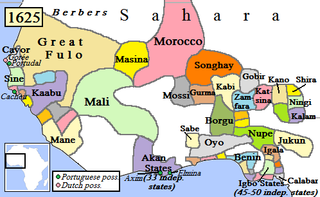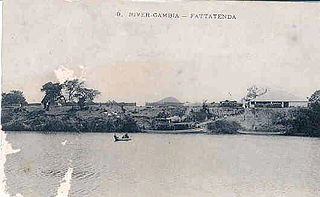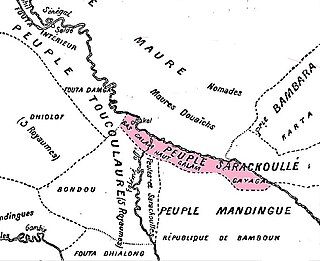
The Mali Empire was an empire in West Africa from c. 1226 to 1670. The empire was founded by Sundiata Keita and became renowned for the wealth of its rulers, especially Mansa Musa. At its peak, Mali was the largest empire in West Africa, widely influencing the culture of the region through the spread of its language, laws, and customs.

The Gambia River is a major river in West Africa, running 1,120 kilometres (700 mi) from the Fouta Djallon plateau in north Guinea westward through Senegal and The Gambia to the Atlantic Ocean at the city of Banjul. It is navigable for about half that length.

The Mandinka or Malinke are a West African ethnic group primarily found in southern Mali, the Gambia, southern Senegal and eastern Guinea. Numbering about 11 million, they are the largest subgroup of the Mandé peoples and one of the largest ethnic-linguistic groups in Africa. They speak the Manding languages in the Mande language family, which are a lingua franca in much of West Africa. Virtually all of Mandinka people are adherent to Islam, mostly based on the Maliki jurisprudence. They are predominantly subsistence farmers and live in rural villages. Their largest urban center is Bamako, the capital of Mali.

Bundu was a state in West Africa existing from the late 17th century until it became a French protectorate dependent on the colony of Senegal. It lay between the Falémé River and the upper course of the Gambia River, that is between 13 and 15 N., and 12 and 13 W.

Tambacounda is the largest city in eastern Senegal, 400 kilometres (250 mi) southeast of Dakar, and is the regional capital of the province of the same name. Its estimated population in 2007 was 78,800.

Janjanbureh or Jangjangbureh is a town, founded in 1823, on Janjanbureh Island, also known as MacCarthy Island, in the Gambia River in eastern Gambia. Until 1995, it was known as Georgetown and was the second largest town in the country. It is the capital of Janjanbureh Local Government Area, and the Janjanbureh district. The population of the Janjanbureh LGA was 127,333 at the 2013 population census.
al-Hajj Mahmadu Lamine Drame,also known as Ma Lamine Demba Dibassi, was a nineteenth-century Tijani marabout who led a series of rebellions against the French colonial government in what is now Senegal.

Kaabu (1537–1867), also written Gabu, Ngabou, and N'Gabu, was a federation of Mandinka kingdoms in the Senegambia region centered within modern northeastern Guinea-Bissau, large parts of today's Gambia, and extending into Koussanar, Koumpentoum, and the Casamance in Senegal.
Mamadu Diakhou Bâ, also known as Maba Jahou Bah, Ma Ba Diakhu, Ma Ba Diakho Ba, Ma Ba Jaaxu, Mabba Jaxu Ba, was a Muslim leader in West Africa during the 19th century. He was a disciple of the Tijaniyya Sufi brotherhood and became the Almami of Saloum.
Tiramakhan Traore was a 13th-century general in the Mali Empire who served under Sundiata Keita. Traore expanded the power of Mali westward and set up the Kabu Empire. In his conquest of the region, he is reported to have defeated the Bainuk king Kikikor and annexed his state. The Guelowar royal family, including the royal family of Kaabu prior to their defeat at the Battle of Kansala, claimed descent from Tiramakhan Traore.
The military history of the Mali Empire is that of the armed forces of the Mali Empire, which dominated Western Africa from the mid 13th to the late 15th century. The military culture of the empire's driving force, Mandinka people, influenced many later states in West Africa including break-away powers such as the Songhay and Jolof empires. Institutions from the Mali Empire also survived in the 19th century army of Samory Ture who saw himself as the heir to Old Mali's legacy.

Fattatenda is a small village in eastern Gambia on the Gambia River. It is located in Wuli District in the Upper River Division, a few kilometers southwest of the much larger village of Baja Kunda. As of 2009, it has an estimated population of 49.
Barrow Kunda is a town in the Gambia. It is located in Wuli District in the Upper River Division. According to tradition the village was founded in the 16th century by Alai Bah, a marabout from Futa Toro. The king of Wuli at the time, Mansa Jalali Wali convinced him to settle there by promising him autonomy to practice Islam and protection from search and seizure.
The Battle of Kansala or Turban Keloo was the siege of the capital of the Kaabu federation by the Imamate of Futa Jallon, allied with rebellious Fula people from Kaabu itself. The battle, which saw the town completely destroyed, ended Mandinka hegemony over Africa’s Atlantic coast begun by the Mali Empire.
Koli Tenguella was a Fulani warrior and leader who was pivotal in establishing the Empire of Great Fulo.
Tenguella was a Fula silatigi or chief who founded a short-lived state in the upper Senegal river valley, a precursor of the Empire of Great Fulo. He was referred to as the Great Fulo or Great king of the Fulos in Portuguese documents of the time.
Sutukoba, sometimes referred to as Sutuko, is a village in The Gambia located in the Upper River Region, 332 km east of the capital Banjul and 38 km northeast of the regional capital Basse Santa Su. The population in 2013 was 3317.

Gajaaga, also known as Galam, was a Soninke kingdom in on the upper Senegal river that existed from before 1000CE to 1858. The area today is split between Senegal and Mali. It was sometimes referred to as the Land of Gold, which it exported in large quantities, and 'Galam' in fact means 'gold' in Wolof. In the middle of the 17th century, Gajaaga was perhaps the most powerful state in the upper Senegal river region. It controlled both banks of the river from the area of Kayes downstream to Bakel.
The Tenda or Tanda are an ethnolinguistic group living in the southern Senegal, northeastern Guinea-Bissau, and northern Guinea, comprising the Bassari, the Konyagui, the Bedik, and the Badiaranke.
Niani was a Mandinka kingdom located on the north bank of the Gambia River from approximately the 14th to the late 19th century in what is now The Gambia and Senegal.









